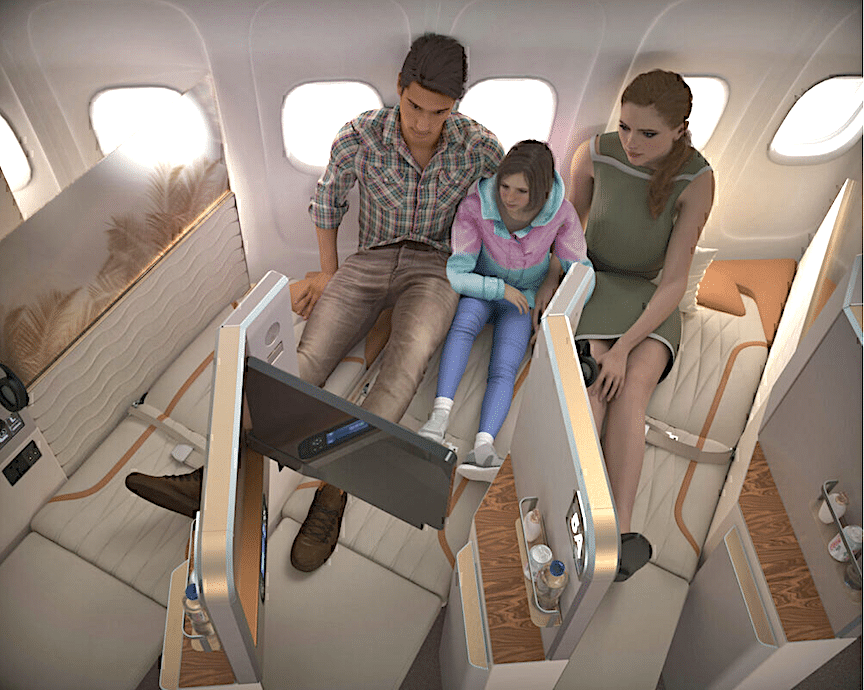
A family of three can lower the frosted glass partitions between their seats and enjoy being together throughout the flight. Photo by AirGo
By Amanda Morris
Summer travel is in full swing. The days of open middle seats are fading fast. As airlines move toward full capacity some industry suppliers are imagining new ways to redesign aircraft interiors. Their goal: maximize airline profits while keeping crowded passengers comfortable in both business and economy.
AirGo hopes less will equal more
AirGo, a Singapore-based design and engineering company, is creating digital blueprints that could revolutionize lie-flat business class seating with its new AirGo Galaxy. Instead of having one kind of seat arranged at different angles as is the general practice now, the Galaxy design uses two different kinds of seats, one alongside the windows and another in the middle of a two-aisle widebody aircraft. AirGo admits that travelers would have to give up some space.
Window seats would resemble a pull-out sofa, separated by divider walls that can be dropped down to enable families to lie flat together. With a small pitch of 27.6 inches, families can relax without taking up too much prime business class real estate. With the dividers down, a family can sleep flat at slightly different angles in the space of a queen-size bed. The seats that turn into beds, however, are narrow at only 20 inches across.
Passengers traveling alone, or couples that need a privacy break from their travel companion, can raise the dividers between the sofa beds.
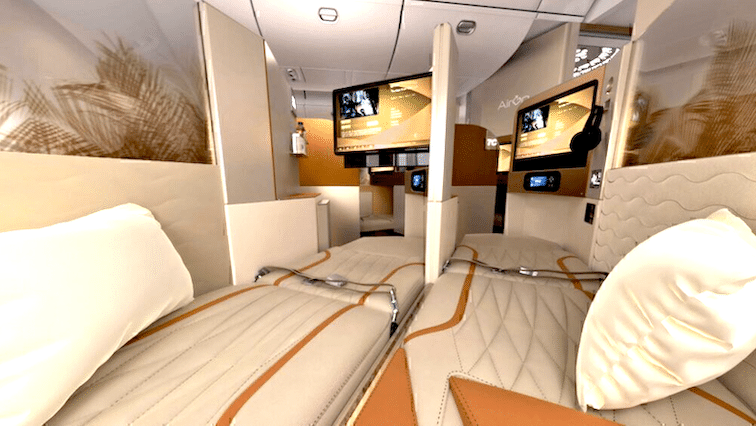
Business class seats convert to beds that are more than 6-ft. in length. Photo by AirGo
Travelers seated in the middle of the plane will find more traditional business class seating with a pitch of around 47. 6 inches. These seats, like those on the sides, convert to a lie-flat bed 6-ft, 3-in long and 20 inches across.
By using two different kinds of seats that are smaller than what business travelers now experience, airlines would be able to have more business class seats on their planes. In theory, having more business class seats on a plane would allow them to be more affordable. Using AirGo’s plan, a Boeing 777 could accommodate 36 business class seats compared to its current 28.
This design has the potential to allow business class seats to be more affordable. But will business travelers, many of whom are flying with a ticket purchased by their employer, tolerate less space than what they currently enjoy on a long-haul flight?
Bunk beds in Economy?
Innovation does not end in business class. Indeed, the most provocative new design concept would provide lie-flat seating in economy class. Proposed by ADSE Consulting and Engineering in the Netherlands, the Economy-Sky Dream configuration finally would provide “premium economy” with real value. As described by Simple Flying Managing Editor Joanna Bailey, the Dutch concept would take the space presently used for overhead storage bins to create three bunk beds that would allow economy passengers to stretch out and sleep on long transoceanic flights.
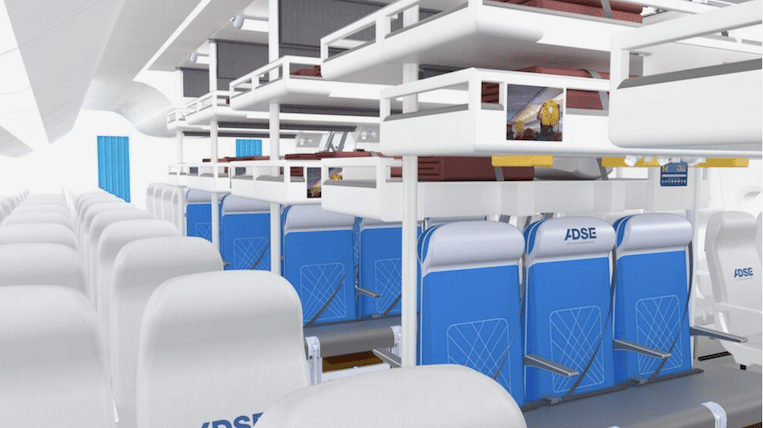
Groups of six passengers sit facing each other until the aircraft reaches its cruising altitude. At that point, four passengers climb a ladder to their bunks while the remaining two pull the three seat backs down to make a bed over the bench. Photo by ADSE
Recently named as a finalist in the 2021 Crystal Cabin Awards, the radical new design “offers a superb economy class sleeping experience for long-haul flights,” insists ADSE. “It is unique in its class as it offers a space-efficient solution that meets applicable certification requirements and creates an additional revenue opportunity for airlines.”
The bunks would occupy the middle part of a widebody jet’s economy section. An economy row that has four seats across would be reconfigured to seat three people separated by armrests that pivot upward from below the bench.
In this plan, six passengers would sit facing each other on redesigned benches, not separated seats. Tray tables would be redesigned to reside within the movable armrests in order to allow space for the bunk beds.
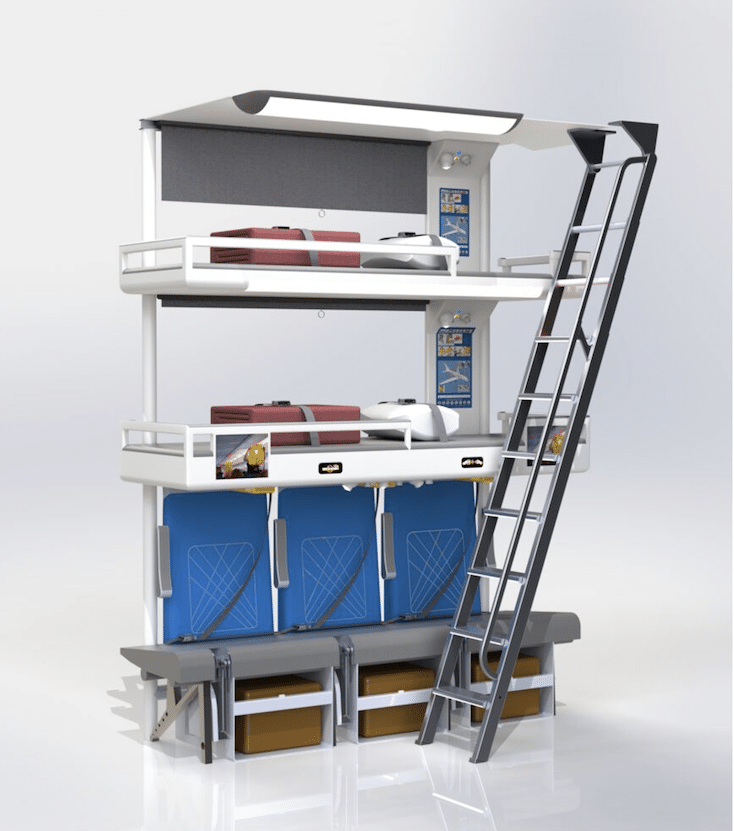
ADSE’s Sky Dream configuration complements traditional economy seating that will remain next to the airframe’s fuselage. Cabin luggage formerly stored in the overhead bins can be placed beneath the bench where three passengers sit for take-offs and landings. Photo by ADSE
After the plane takes off and reaches its cruising altitude, passengers would lower their armrests and stand while a ladder unfolds from the ceiling of the plane. Two passengers would climb up the ladder to their respective bunks. A third bunk would fold down like the passenger bed on a railroad Pullman car, turning the bench where people sat for takeoff into the third bed.
Each bunk will come with a speaker as well as the standard amenities of a normal seat: a call button, a light and a seatbelt to stay strapped in during turbulence.
Like riding on a carousel
Economy passengers seeking extra comfort on a long flight may find a Sky Dream bunk worth the money. But what about budget-conscious travelers on a short flight just looking for a cheap ticket? For them, Italian seat designer Aviointeriors offers the Skyrider, a vertical standing chair that claims to keep the passenger comfortable on what amounts to a “perch” on a carnival ride. Aviointeriors admits the Skyrider takes up significantly less room than the standard seat. It cautions that the seats should only be used on flights less than three hours long because of the vertical nature of the chair.
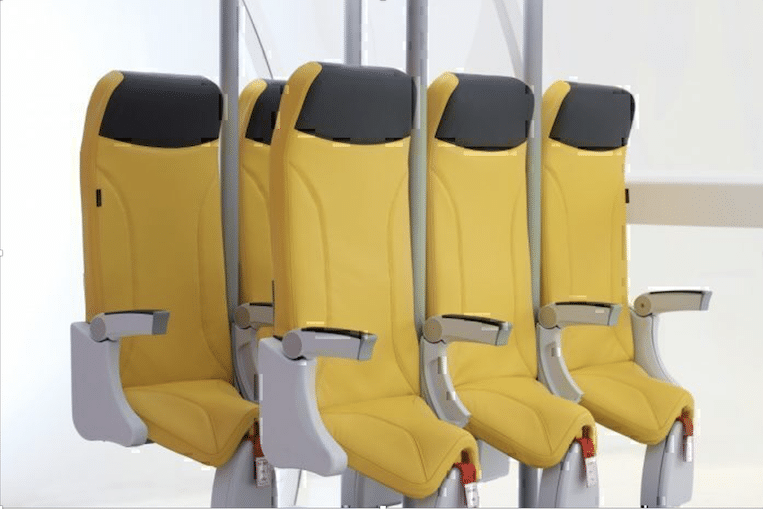
Vertical positioning and lack of lumbar support limits the Skyrider seat to flights of three hours or less. Photo by Aviointeriors
Zero Gravity enters the airplane
Aviointeriors is bringing the science behind zero gravity into one of its newest seating designs in order to make time spent in the air a bit more comfortable for business class travelers. The Skywave seat, which almost looks like a chair you’d find in the dentist’s office, will extend the length of a passenger’s entire body. It not only conforms to the shape of the passenger’s body but also can change shape based on an individual’s movement during the flight. Like the Skyrider, which fills a low-cost niche in economy, the Skywave is designed for business class travelers who can’t afford a lie-flat seat but still want to be comfortable.
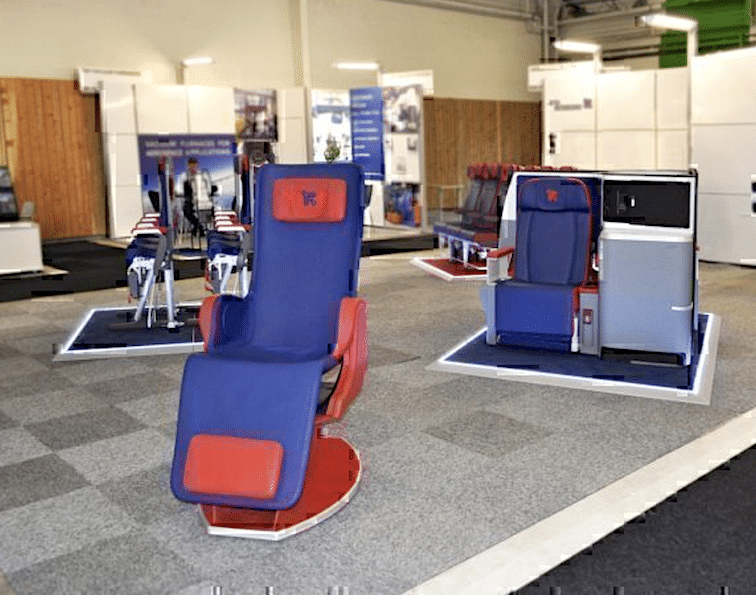
The zero-gravity Skywave seat could provide a comfortable alternative to traditional business class. Photo by Aviointeriors
Space efficiency
Another option by Aviointeriors is Adagio, a business class cubicle that would provide access to 100% of the aisle. This benefit will be appreciated not only by flight attendants but by anyone who does not like collisions with the beverage cart. Adagio has a lie-flat configuration. Best of all, it is built with memory foam to ensure passengers stay supported and comfortable while in the air.
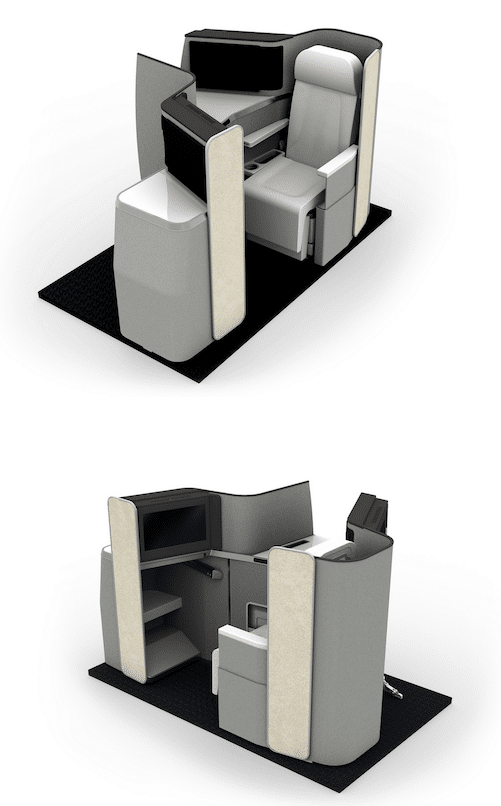
Aviointeriors hopes a sleek and simple design like Adagio will appeal to aircraft interior manufacturers. Photo by Aviointeriors.
COVID aware options
Even with rising vaccine rates, the idea of sitting beside strangers like we used to may not sit well with some. Another seat by Aviointeriors may provide peace of mind to health-conscious travelers. It is called the Glasssafe seat. Many new seat options require complete renovations and overhauls of airplanes. Glasssafe would simply add a transparent shield that would allow for increased isolation between passengers on planes.
Up, Up and Away
For all the massive changes airlines have undergone since the Wright Brothers took off from Kitty Hawk, airline seats have remained pretty much the same. But not anymore. People are thinking outside the box of ways to increase revenue and make travel more comfortable for the passenger. Air travel has changed tremendously throughout the past year and a half. It’s hard to say if it ever will be completely “normal” again. However air travel evolves there’s a good chance airline seats will change too.![]()
Amanda Morris is a senior at Syracuse University, pursuing a degree in Television, Radio, and Film at the S.I. Newhouse School of Public Communications.

